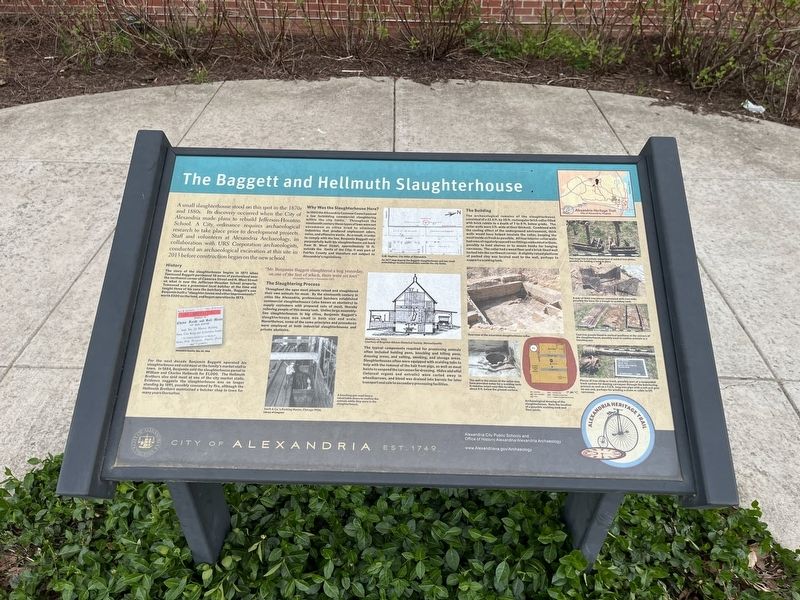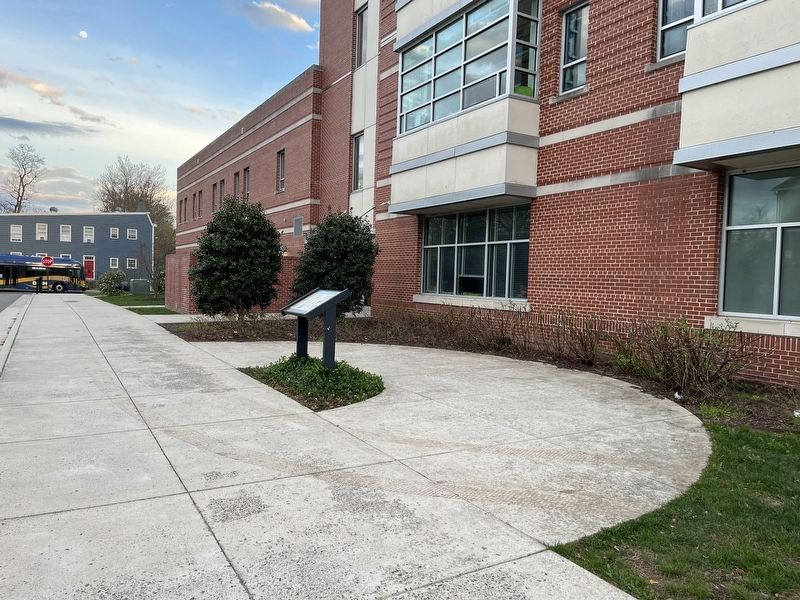Old Town West in Alexandria, Virginia — The American South (Mid-Atlantic)
The Baggett and Hellmuth Slaughterhouse
Alexandria Heritage Trail
— City of Alexandria, est. 1749 —

Photographed By Devry Becker Jones (CC0), April 14, 2022
1. The Baggett and Hellmuth Slaughterhouse Marker
A small slaughterhouse stood on this spot in the 1870s and 1880s. Its discovery occurred when the City of Alexandria made plans to rebuild Jefferson-Houston School. A City ordinance requires archaeological research to take place prior to development projects. Staff and volunteers at Alexandria Archaeology, in collaboration with URS Corporation archaeologists, conducted an archaeological excavation at this site in 2013 before construction began on the new school.
History
The story of the slaughterhouse begins in 1871 when Townsend Baggett purchased 10 acres of pastureland near the northwest corner of Cameron Street and N. West Street on what is now the Jefferson-Houston School property. Townsend was a prominent local butcher at the time and taught three of his sons the butchery trade. Baggett's son Benjamin built a "slaughter house and other improvements" worth $500 on the land, and began operation by 1873.
For the next decade Benjamin Baggett operated his slaughterhouse and sold meat at the family's market stall in town. In 1884, Benjamin sold the slaughterhouse parcel to William and Charles Hellmuth for $1,000. The Hellmuth Brothers also sold meat at one of the city market stalls. Evidence suggests the slaughterhouse was no longer standing by 1891, possibly consumed by fire, although the Hellmuth Brothers maintained a butcher shop in town for many years thereafter.
Why Was the Slaughterhouse Here?
In 1803 the Alexandria Common Council passed a law forbidding commercial slaughtering within city limits. Throughout the nineteenth century these types of laws were not uncommon as cities tried to eliminate industries that produced unpleasant odors, noise, and offensive waste. As a result, in order to comply with the law, Benjamin Baggett very purposefully built his slaughterhouse set back from N. West Street, approximately 15 ft. outside the limits of the City; it was part of Fairfax County and therefore not subject to Alexandria's regulations.
"Mr. Benjamin Baggett slaughtered a hog yesterday, on one of the feet of which, there were six toes"
Alexandria Gazette 4 December 1873
The Slaughtering Process
Throughout the ages most people raised and slaughtered their own animals for meat. By the nineteenth century in cities like Alexandria, professional butchers established commercial slaughterhouses (also known as abattoirs) to supply customers with prepared cuts of meat, thereby relieving people of this messy task. Unlike large assembly-line slaughterhouses in big cities, Benjamin Baggett's slaughterhouse was small in both size and scale. Nevertheless, some of the same principles

Photographed By Devry Becker Jones (CC0), April 14, 2022
2. The Baggett and Hellmuth Slaughterhouse Marker
The typical components required for processing animals often included holding pens, knocking and killing pens, dressing areas, and salting, smoking, and storage areas. Slaughterhouses often were equipped with scalding tubs to help with the removal of the hair from pigs, as well as meat hoists to suspend the carcasses for dressing. Hides and offal (internal organs and entrails) were carried away in wheelbarrows, and blood was drained into barrels for later transport and sale to secondary processing facilities.
The Building
The archaeological remains of the slaughterhouse consisted of a 22.5 ft. by 20 ft. rectangle brick cellar filled with brick rubble to a depth of 7 to 8 ft. below grade. The cedar walls were 3 ft. wide at their thickest. Combined with the cooling effect of the underground environment, thick walls would have helped insulate the cellar, keeping the meat inside as fresh as possible. All four interior cellar walls had rows of regularly spaced iron fittings embedded in them, possibly to hold shelves or to mount hooks for hanging carcasses. The cellar had a wood floor and a brick-lined well tucked into the northwest corner. A slightly raised platform of packed clay was located next to the well, perhaps to support a scalding tank.
[Captions:]
A knocking pen used heavy retractable doors to confine the animals while they were in the slaughterhouse.
An 1877 map depicts the Baggett slaughterhouse and two small outbuildings located immediately outside the city limits.
The well in the corner of the cellar may have provided water for a scalding tank. It remains intact near this location, about 8 ft. below the ground surface.
Archaeological drawing of the slaughterhouse. Note the location of a possible scalding tank and floor joists.
Two large iron brackets comprised of welded iron plates, possibly for holding a hoist in place.
A pair of thick iron pieces connected with iron rods, possibly the base for a trough or scalding tank.
Cast iron panels found in vertical positions at the corners of the slaughterhouse, possibly used to confine animals in a knocking pen
Pieces of iron strap or track, possibly part of a suspended track system for moving carcasses through the butchering process as well as a 7.5 ft. long iron pipe with a coil and gear on one end, perhaps for winding a chain or cable to lift carcasses
Erected by City of Alexandria, Virginia.
Topics and series. This historical marker is listed in these topic lists: Animals • Anthropology & Archaeology • Industry & Commerce. In addition, it is included in the Virginia, The City of Alexandria series list. A significant historical date for this entry is December 4, 1873.
Location. 38° 48.514′ N, 77° 3.286′ W. Marker is in Alexandria, Virginia. It is in Old Town West. Marker is on North West Street just north of Queen Street, on the right when traveling south. Touch for map. Marker is at or near this postal address: 1426 Princess St, Alexandria VA 22314, United States of America. Touch for directions.
Other nearby markers. At least 8 other markers are within walking distance of this marker. Carver Nursery School / Post 129 (approx. 0.2 miles away); Alexandria, D.C. (approx. 0.2 miles away); Freedom House Museum (approx. 0.2 miles away); Colonel Francis Peyton (approx. 0.2 miles away); The Growth of Upper King Street (approx. 0.2 miles away); Port City (approx. ¼ mile away); Carver School (approx. ¼ mile away); Colross-Alexandria's Urban Phoenix (approx. ¼ mile away). Touch for a list and map of all markers in Alexandria.
Credits. This page was last revised on May 25, 2023. It was originally submitted on April 15, 2022, by Devry Becker Jones of Washington, District of Columbia. This page has been viewed 202 times since then and 30 times this year. Photos: 1, 2. submitted on April 15, 2022, by Devry Becker Jones of Washington, District of Columbia.